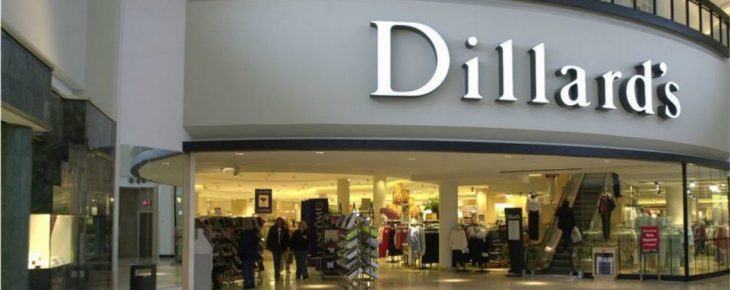Dillard’s posts $40.7 million loss on weak sales
by August 15, 2019 8:13 pm 3,472 views

Little Rock-based Dillard’s, Inc. went backwards in the second quarter as the upscale retailer saw a decline in same-store and total merchandise sales as increasing markdowns and lukewarm purchases of ladies’ apparel and accessories cut into profits.
For the 13-week period ended Aug. 3, the Arkansas department store operator reported a net loss of $40.7 million, or $1.59 per share, compared to a net loss of $2.9 million, or 10 cents per share, in the same period of 2018. Those poor results included a pretax gain of $4.9 million primarily related to the sale of a store property.
Companywide, Dillard’s net sales for the 13-week period declined 2.7% to nearly $1.43 billion, compared to about $1.47 billion in the same period a year ago. That weak quarterly financial performance fell well short of Wall Street’s forecast of a net loss of seven cents per share on quarterly sales of $1.49 billion, according to Thomas Reuters.
Dillard’s shares, which have traded in the range of $53.95 as a low and $86.71 as high over the past 52 weeks, ended Thursday’s session on the New York Stock Exchange at $56.59, down $2.17 or 3.7%. In afterhours trading, even as the broader market was responding to bullish reports in the retail sector from Walmart and Alibaba, Dillard’s shares were trading well below its yearly low, declining $6.38 or 11.3% at $50.20 per share.
Sticking to the Arkansas retailer’s long-held policy of remaining mostly silent concerning the company’s operational and financial performance, Dillard’s CEO William Dillard III offered no response to the dire second quarter report. However, industry bellwether Macy’s Inc. did offer some insight into how brick-and-mortar retailers continue to lose market share to online rivals.
On Tuesday, Macy’s Chairman and CEO Jeff Gennette described a difficult marketplace for traditional retailers after the Cincinnati, Ohio-upscale retailer’s posted second quarter earnings and sales that were well below Wall Street expectations and year ago results. That weak financial performance caused Macy’s stock to fall more than 13% in Wednesday’s big selloff.
“Macy’s, Inc. delivered another quarter of comparable sales growth. That said, we had a slow start to the quarter and finished below our expectations,” said Gennette. “Rising inventory levels became a challenge based on a combination of factors: a fashion miss in our key women’s sportswear private brands, slow sell-through of warm weather apparel and the accelerated decline in international tourism. We took markdowns to clear the excess Spring inventory and are entering the Fall season with the right inventory to meet anticipated customer demand.”
On the plus side, the Macy’s executive said the company’s digital business posted its fortieth consecutive quarter of double-digit growth, and mobile remained its fastest growing channel.
“Our 2019 strategic initiatives are on track to contribute to sales growth in the back half of the year, and we have plans to drive productivity and improve gross margins,” he said.
For Dillard’s, the company’s financial metrics were much like its Ohio competition. Same stores sales, a key metric of the retail industry, declined 2% as revenue growth was strongest on the East Coast, followed by the Western and Central regions.
Year-over-year gross margin from retail operations, which excludes the company’s CDI construction business, also fell 224 points on sales for the 13 weeks ended Aug. 3, primarily due to a decline in department store markdowns. Consolidated gross margin for the 13-week period slid 319 basis points of sales compared to year ago, while inventory levels year-over-year remained flat.
Dillard’s operating expenses were nearly $409.1 million in the second quarter, which is 28.7% of total sales, compared to $408.4 million and 17.8% in 2018. The company’s retail operating expenses for the same 13-week periods were $407.6 million, or 29.6% of sales, versus $406.5 million and 28.9% of sales in the same period of last year.
The Little Rock retailer said it purchased 800,000 of the company’s Class A common stock shares at a price of $48.9 million under the company’s current $500 million stock buyback program. Year-to-date, the company has purchased 1.1 million shares at $66.3 million under the share repurchase program.
Dillard’s, which has total store space of 48.8 million square feet across 29 states, said it plans to close its 70,000 square foot Oakwood Mall location in Enid, Okla., another 145,000 square foot department story in Cary, N.C., and the 100,000 square foot Mall of the Bluffs clearance center in Council Bluffs, Iowa.
Dillard’s operates 260 retail locations, 29 clearance centers, and an Internet store at www.dillards.com.
